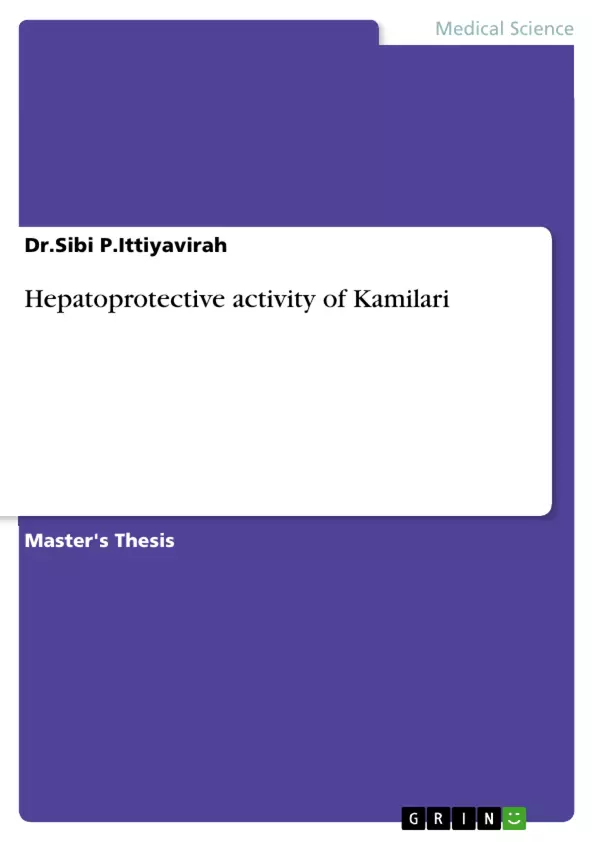Polyherbal formulations available with a wide range of indications like hepatoprotective , appetite and growth promoters, gastrointestinal and hepatic regulator, as treatment for hepatic dysfunction, for hepatic regeneration as well as liver stimulant and tonic. Despite the widespread use, there is a lack of scientific evidence on their efficacy and safety. This study was designed to evaluate the effect of Polyherbal formulation Kamialri on oxidative stress and associated damages in carbon tetrachloride induced toxicity in Chang liver cells. The study is mainly focused on the evaluation of its antioxidant potential, invitro steatosis and intracellular localisation of reduced glutathione by Monochlorobimane(MCB) staining. Carbon tetrachloride induced toxicity in chang liver cells was well manifested by significant decrease in cell viability, enhanced lipid peroxidation leading to tissue damage,decreased SOD, glutathione, glutathione peroxidase and glutathione S- transferase and increased deposition of fatty acid . MTT study revealed that Kamilari has got cytoprotective activity. It has got the excellent free radical scavenging properties which was proven by various antioxidant activities (LP, SOD, GSH, GPX, and GST). Inhibitory effect of Kamilari on fatty acid deposition was proven by invitro steatosis studies which were conducted on palmitic acid treated chang cell line.Based on the above studies it is concluded that Kamilari has cytoprotective and antioxidant activity, and found to be effective in steatosis.
Table of Contents
- Introduction
- MATERIALS & METHODS
- Invitro protective effect of Kamilari in Ccl4 treated Chang liver cells
- Lipid peroxidation
- Estimation of SOD activity
- Estimation of reduced glutathione
- Assay of Glutathione peroxidase
- Glutathione -s-transferase
- Oil Red O (Spectrophotometric method)
- Monochlorobimane (MCB) Flourescent Staining
- Culturing and maintenance of Chang liver cells
- Cell culture and treatment
- Hepatoprotective effect of kamilari on Ccl4 induced toxicity in Chang liver cells
- Cytoprotective effect of Kamilari in chang liver cellsMTT ASSAY
- Effect of Kamilari on Ccl4 induced oxidative damage
- Cell lysis
- Estimation of lipid peroxidation
- Estimation of SOD activity
- Estimation of reduced glutathione
- Assay of Glutathione peroxidase
- Glutathione -s-transferase
- Invitro induction of hepatic steatosis by supplementation of Palmitic acid
- Preparation of Palmitic acid BSA Colloidal Solution
- Oil Red O (spectrophotometric method)
- Oil Red O (microscopic method)
- Intracellular Localisation of reduced glutathione by Monochlorobimane (MCB) Flourescent Staining
- Statistical analysis
- RESULTS
- Cytoprotective effect of Kamilari in Chang liver cells
Objectives and Key Themes
This study aims to evaluate the hepatoprotective effects of the polyherbal formulation Kamilari in Chang liver cells. Specifically, it investigates the effects of Kamilari on oxidative stress and associated damages induced by carbon tetrachloride (Ccl4).
- Antioxidant potential of Kamilari
- In vitro steatosis effects of Kamilari
- Intracellular localization of reduced glutathione in Ccl4-induced toxicity
- Cytoprotective activity of Kamilari in Ccl4-treated Chang liver cells
- The role of Kamilari in mitigating oxidative stress and associated damages in the liver
Chapter Summaries
The "Introduction" section provides an overview of the importance of the liver and its role in various physiological processes. It also highlights the use of in vitro liver systems for screening potential hepatotoxic compounds and the widespread use of carbon tetrachloride (Ccl4) as a model toxicant in toxicological studies. The section then introduces Kamilari, a commercial Ayurvedic formulation suggested to be effective in treating liver disorders, and outlines the rationale for this study.
The "MATERIALS & METHODS" section details the experimental procedures used in the study, including the cell culture and treatment methods, as well as the various assays employed to assess the effects of Kamilari on different aspects of liver function. These assays include MTT assay, lipid peroxidation, SOD activity, reduced glutathione estimation, glutathione peroxidase assay, glutathione S-transferase assay, Oil Red O staining, and MCB fluorescent staining.
The "RESULTS" section presents the findings of the study. This section focuses on the cytoprotective effect of Kamilari in Chang liver cells, which was evaluated through the MTT assay, and its impact on Ccl4-induced oxidative damage. The findings of the study, including the effects of Kamilari on lipid peroxidation, SOD activity, reduced glutathione levels, glutathione peroxidase, glutathione S-transferase, and the induction of hepatic steatosis by palmitic acid, will be discussed in this section.
Keywords
This research focuses on the hepatoprotective activity of a polyherbal formulation, Kamilari, in a Chang liver cell model. Key research areas include oxidative stress, steatosis, antioxidant activity, Ccl4-induced toxicity, and the role of reduced glutathione in protecting against liver damage. The study aims to provide scientific evidence for the efficacy and safety of Kamilari in treating liver disorders.
- Quote paper
- Dr.Sibi P.Ittiyavirah (Author), 2012, Hepatoprotective activity of Kamilari, Munich, GRIN Verlag, https://www.grin.com/document/268298



